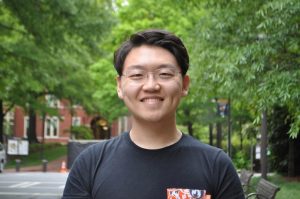Two graduate students from the Daniel Guggenheim School of Aerospace Engineering learned this week that their doctoral research -- on Hall thruster efficiency and on novel space navigation architectures -- will be fully supported by NASA's Space Technology Research Fellowship program beginning this fall.
David Gomez and William Jun are among a handful of promising graduate students selected by NASA for the fellowship, which is bestowed each year to encourage research in groundbreaking, high-risk/high-payoff, early stage space technologies. A third NSTRF recipient, Ethan Hopping, will leave his job at Blue Origin this fall to begin his full-time doctoral studies under the guidance of Prof. Mitchell Walker.
"This is precisely the sort of research that the Daniel Guggenheim School is poised to pursue," said William R. T. Oakes Chair Mark F. Costello.
"We are proud of this year's NSTRF scholars, certainly, but more than that, we are confident that the smart risks they take today will be the innovations that define the discipline in the future."
 |
| David B. Gomez |
David B. Gomez
"Development of a Highly Throttlable, Bipropellant (Xe-Kr) Hall Thruster and Investigations into the Newly Discovered Oscillation Modes in Magnetically Shielded Thrusters”
Working in the High Power Electric Propulsion Lab under the guidance of Prof. Mitchell L. R. Walker, Gomez plans to use his NSTRF to explore ways of limiting the high-frequency oscillation modes that kick-in when electrically powered Hall thrusters operate at a discharges that exceeds 800 volts. Any solutions he can define will eventually help the future of interplanetary travel.
"It's complicated, really, and that's what keeps me going. The primary failure mode, with Hall thrusters, has generally been from the bombardment of ions on the walls of the thruster. Recent changes in technology are eliminating this wall erosion by changing the shape of the magnetic field," he said.
"The problem, now, is that you want to increase the voltage on these thrusters -- the higher the voltage, the higher the efficiency of the thruster -- but at certain high-voltage discharges, the thruster starts to shake. And that instability is a problem."
Gomez says his research will focus on the many things not yet known about these high-frequency oscillation modes, with an eye toward eventually developing a bipropellant Hall thruster -- suitable for both high-thrust orbital insertions and interplanetary cruise phases. He plans to return to NASA's Jet Propulsion Laboratory this summer to continue research in this same area that he began last summer.
 |
| William W. Jun |
William W. Jun
"A Novel Navigational Architecture for Localization on other Planets using a Single-Satellite with Limited Satellite Resources"
William W. Jun's childhood dreams of blasting into space have tamped down a bit since coming to Tech. The inspiration is still there, though.
"I'd still jump at the chance to become an astronaut" says the Jupiter, Florida native.
"But, really, what I find more interesting about space, now, is the science. If the research I do can help expand our understanding and further our exploration of space, I'll be happy."
Jun's graduate research will keep him in the running for both dreams. Working alongside his advisor, Prof. E. Glenn Lightsey, he will use his NSTRF to support research into a new Doppler-based tracking system to be used to locate land rovers - and, eventually, people - on distant planets.
"I developed an algorithm that allows us to determine the location of something on the surface of another planet-accurate to within 7 meters - with the use of only Doppler measurements, a reference station, and just one satellite," he said. "That might not sound too impressive until you remember that it takes as many as 24 satellites operating overhead for your phone's GPS to find anything. It would be impractical to send 24 satellites up to orbit Europa or Mars."
"And the great thing is, we don't have to."
Though his research is just beginning, Jun said he is encouraged by its potential for streamlining space navigation.
"Right now, the way we localize something is by using a lot of data fusion methods which require a lot of measurement and need to be routed back to Earth for processing," he said. "With this method, we can limit ourselves to the hardware that's already installed on most vehicles and the data can be processed right there.Theoretically, we could do this right away. The hardware is already there."
Jun said he will work with Lightsey to improve and increase the Technology Readiness Level (TRL) of this algorithm, using the high fidelity equipment in Lightsey's lab.